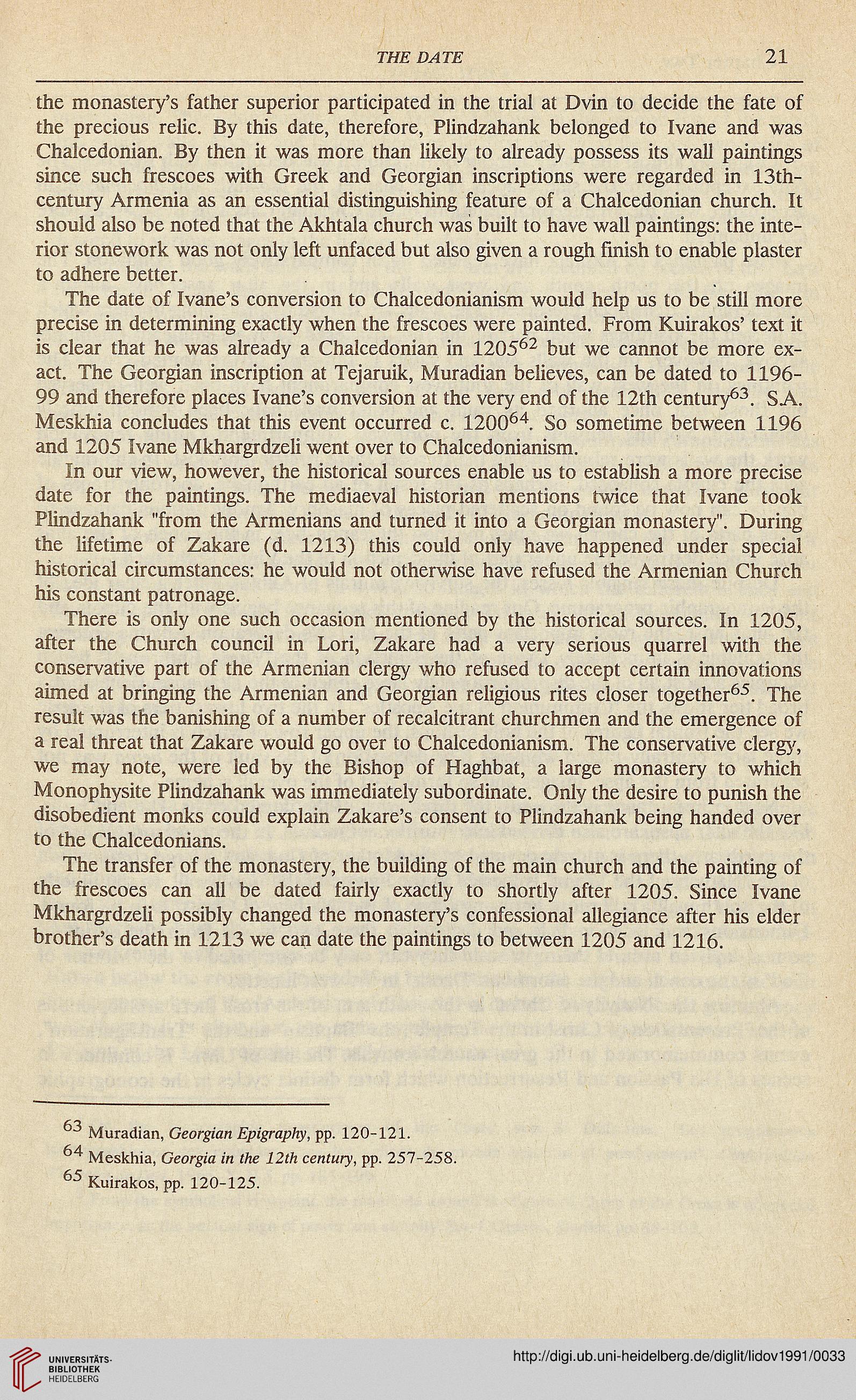77M? A4TF
21
the monastery's father superior participated in the trial at Dvin to decide the fate of
the precious relic. By this date, therefore, Piindzahank belonged to Ivane and was
Chalcedonian. By then it was more than likely to already possess its wall paintings
since such frescoes with Greek and Georgian inscriptions were regarded in 13th-
century Armenia as an essential distinguishing feature of a Chalcedonian church. It
should also be noted that the Akhtala church was built to have wall paintings: the inte-
rior stonework was not only left unfaced but also given a rough finish to enable plaster
to adhere better.
The date of 1 vane's conversion to Chalcedonianism would help us to be still more
precise in determining exactly when the frescoes were painted. From Kuirakos' text it
is clear that he was already a Chalcedonian in 120562 but we cannot be more ex-
act. The Georgian inscription at Tejaruik, Muradian believes, can be dated to 1196-
99 and therefore places Ivane's conversion at the very end of the 12th century^. SA.
Meskhia concludes that this event occurred c. 120064 So sometime between 1196
and 1205 Ivane Mkhargrdzeli went over to Chalcedonianism.
In our view, however, the historical sources enable us to establish a more precise
date for the paintings. The mediaeval historian mentions twice that Ivane took
Piindzahank "from the Armenians and turned it into a Georgian monastery ". During
the lifetime of Zakare (d. 1213) this could only have happened under special
historical circumstances: he would not otherwise have refused the Armenian Church
his constant patronage.
There is only one such occasion mentioned by the historical sources. In 1205,
after the Church council in Lori, Zakare had a very serious quarrel with the
conservative part of the Armenian clergy who refused to accept certain innovations
aimed at bringing the Armenian and Georgian religious rites closer together^. The
result was the banishing of a number of recalcitrant churchmen and the emergence of
a real threat that Zakare would go over to Chalcedonianism. The conservative clergy,
we may note, were led by the Bishop of Haghbat, a large monastery to which
Monophysite Piindzahank was immediately subordinate. Only the desire to punish the
disobedient monks could explain Zakare's consent to Piindzahank being handed over
to the Chalcedonians.
The transfer of the monastery, the building of the main church and the painting of
the frescoes can all be dated fairly exactly to shortly after 1205. Since Ivane
Mkhargrdzeli possibly changed the monastery's confessional allegiance after his elder
brother's death in 1213 we can date the paintings to between 1205 and 1216.
63 Muradian, Georgian pp. 120-121.
64 Meskhia, Georgia in iAe 12iA cenfary, pp. 257-258.
63 Kuirakos, pp. 120-125.
21
the monastery's father superior participated in the trial at Dvin to decide the fate of
the precious relic. By this date, therefore, Piindzahank belonged to Ivane and was
Chalcedonian. By then it was more than likely to already possess its wall paintings
since such frescoes with Greek and Georgian inscriptions were regarded in 13th-
century Armenia as an essential distinguishing feature of a Chalcedonian church. It
should also be noted that the Akhtala church was built to have wall paintings: the inte-
rior stonework was not only left unfaced but also given a rough finish to enable plaster
to adhere better.
The date of 1 vane's conversion to Chalcedonianism would help us to be still more
precise in determining exactly when the frescoes were painted. From Kuirakos' text it
is clear that he was already a Chalcedonian in 120562 but we cannot be more ex-
act. The Georgian inscription at Tejaruik, Muradian believes, can be dated to 1196-
99 and therefore places Ivane's conversion at the very end of the 12th century^. SA.
Meskhia concludes that this event occurred c. 120064 So sometime between 1196
and 1205 Ivane Mkhargrdzeli went over to Chalcedonianism.
In our view, however, the historical sources enable us to establish a more precise
date for the paintings. The mediaeval historian mentions twice that Ivane took
Piindzahank "from the Armenians and turned it into a Georgian monastery ". During
the lifetime of Zakare (d. 1213) this could only have happened under special
historical circumstances: he would not otherwise have refused the Armenian Church
his constant patronage.
There is only one such occasion mentioned by the historical sources. In 1205,
after the Church council in Lori, Zakare had a very serious quarrel with the
conservative part of the Armenian clergy who refused to accept certain innovations
aimed at bringing the Armenian and Georgian religious rites closer together^. The
result was the banishing of a number of recalcitrant churchmen and the emergence of
a real threat that Zakare would go over to Chalcedonianism. The conservative clergy,
we may note, were led by the Bishop of Haghbat, a large monastery to which
Monophysite Piindzahank was immediately subordinate. Only the desire to punish the
disobedient monks could explain Zakare's consent to Piindzahank being handed over
to the Chalcedonians.
The transfer of the monastery, the building of the main church and the painting of
the frescoes can all be dated fairly exactly to shortly after 1205. Since Ivane
Mkhargrdzeli possibly changed the monastery's confessional allegiance after his elder
brother's death in 1213 we can date the paintings to between 1205 and 1216.
63 Muradian, Georgian pp. 120-121.
64 Meskhia, Georgia in iAe 12iA cenfary, pp. 257-258.
63 Kuirakos, pp. 120-125.




